This article needs to be updated.(January 2023) |

Banana production in Tawain is an essential aspect of the agriculture of Taiwan.[ citation needed ] Japanese consumers commonly purchase bananas grown in Taiwan. [1]
This article needs to be updated.(January 2023) |

Banana production in Tawain is an essential aspect of the agriculture of Taiwan.[ citation needed ] Japanese consumers commonly purchase bananas grown in Taiwan. [1]
The banana production begin to grow when Taiwan was being occupied by Japan. [2] By 1939, Taiwan was the third largest exporter of bananas in the world. [3] Taiwan bananas monopolized the Japanese market until 1963, when banana importation was liberalized in Japan. [2] In 1967, banana exports from the country were relatively high. [1] Since 1970, the industry has declined significantly due to competition from the Philippines and problems with the cultivation. [4]
Around 8,000 hectares of land in Taiwan is used for banana cultivation. About 5,000 hectares in Southern Taiwan is used for exported fruit, and about 3,000 hectares in Northern Taiwan is used for domestic consumption.
In 1991, the geographic distribution for banana cultivation land was Kaohsiung County (2,284 hectares), Changhua County, Nantou County, Taichung County (1,862 hectares), Pingtung County (1,254 hectares), Chiayi County, Tainan County, Yunlin County (185 hectares) and Hualien County, Taitung County (108 hectares). [4]
The main export destination of banana from Taiwan is Japan, which peaked in 1967 with 416,000 tons of export. In 1990, the export tonnage declined to 48,000 tons. [4]
The Taiwan Banana Research Institute is tasked to undergo research and development of banana cultivation in Taiwan. [4]

Taiwan, officially the Republic of China (ROC), is a country in East Asia. It is located at the junction of the East and South China Seas in the northwestern Pacific Ocean, with the People's Republic of China (PRC) to the northwest, Japan to the northeast, and the Philippines to the south. The territories controlled by the ROC consist of 168 islands with a combined area of 36,193 square kilometres. The main island of Taiwan, also known as Formosa, has an area of 35,808 square kilometres, with mountain ranges dominating the eastern two-thirds and plains in the western third, where its highly urbanized population is concentrated. The capital, Taipei, forms along with New Taipei City and Keelung the largest metropolitan area. With around 23.9 million inhabitants, Taiwan is among the most densely populated countries.
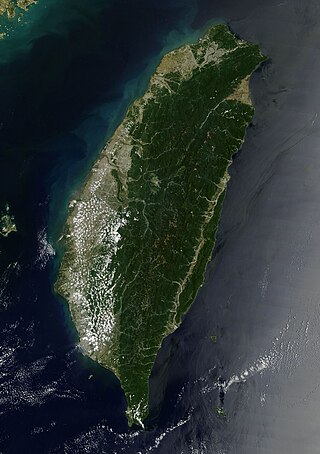
Taiwan, officially the Republic of China (ROC), is an island country in East Asia. The island of Taiwan, formerly known as Formosa, makes up 99% of the land area of the territories under ROC control. The main island is 35,808 square kilometres (13,826 sq mi) and lies some 180 kilometres (112 mi) across the Taiwan Strait from the southeastern coast of the People's Republic of China (PRC). The East China Sea lies to the north of the island, the Philippine Sea to its east, the Luzon Strait directly to its south and the South China Sea to its southwest. The ROC also controls a number of smaller islands, including the Penghu archipelago in the Taiwan Strait, the Kinmen and Matsu Islands in Fuchien near the PRC's coast, and some of the South China Sea Islands.
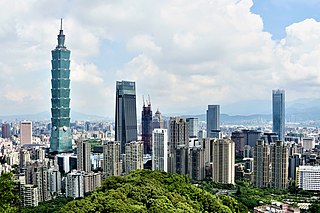
The economy of Taiwan is a highly developed free-market economy. It is the 8th largest in Asia and 20th-largest in the world by purchasing power parity, allowing Taiwan to be included in the advanced economies group by the International Monetary Fund. Taiwan is notable for its rapid economic development from an agriculture-based society to an industrialised, high-income country. This economic growth has been described as the Taiwan Miracle. It is gauged in the high-income economies group by the World Bank. Taiwan is one of the most technologically advanced computer microchip and high-tech electronics industries makers in the world.

The Constitution of the Republic of China is the fifth and current constitution of the Republic of China (ROC), ratified by the Kuomintang during the Constituent National Assembly session on 25 December 1946, in Nanjing, and adopted on 25 December 1947. The constitution, along with its Additional Articles, remains effective in ROC-controlled territories.
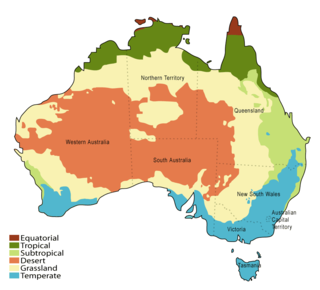
Although Australia is mostly arid, the nation is a major agricultural producer and exporter, with over 325,300 people employed in agriculture, forestry and fishing as of February 2015. Agriculture and its closely related sectors earn $155 billion a year for a 12% share of GDP. Farmers and grazers own 135,997 farms, covering 61% of Australia's landmass. Across the country, there is a mix of irrigation and dry-land farming. The success of Australia in becoming a major agricultural power despite the odds is facilitated by its policies of long-term visions and promotion of agricultural reforms that greatly increased the country's agricultural industry.

Taiwan Provincial Government is the nominal government of Taiwan Province in the Republic of China. Since 2018, its functions have been transferred to the National Development Council and other ministries of the Executive Yuan.

Agriculture in Colombia refers to all agricultural activities, essential to food, feed, and fiber production, including all techniques for raising and processing livestock within the Republic of Colombia. Plant cultivation and livestock production have continuously abandoned subsistence agricultural practices in favour of technological farming resulting in cash crops which contribute to the economy of Colombia. The Colombian agricultural production has significant gaps in domestic and/or international human and animal sustenance needs.

Agriculture is one of the main industries in Taiwan. It contributes to the food security, rural development and conservation of Taiwan. Around 24% of Taiwan's land is used for farming.

Agriculture employs the majority of Madagascar's population. Mainly involving smallholders, agriculture has seen different levels of state organisation, shifting from state control to a liberalized sector.

The recordkeeping and development of the economic history of Taiwan started in the Age of Discovery. In the 17th century, the Europeans realized that Taiwan is located on the strategic cusp between the Far East and Southeast Asia. Two main European empires that competed to colonize it were the Dutch and Spanish Empires. Taiwan also became an intermediate destination for trade between Western European empires and East Asia states. The history of Taiwan as a colony of the Dutch Empire, Kingdom of Tungning, Qing China, and Empire of Japan between 1630 and 1945 was based heavily on economics.

The Ministry of Economic Affairs is the ministry of the Republic of China (Taiwan) responsible for formulating policy and laws for industry and trade, foreign direct investment, energy, minerals, measurement standards, intellectual property, state-owned enterprises. The ministry is a cabinet level government agency of the Executive Yuan.

Throughout its history, agriculture in Paraguay has been the mainstay of the economy. This trend has continued today and in the late 1980s the agricultural sector generally accounted for 48 percent of the nation's employment, 23 percent of GDP, and 98 percent of export earnings. The sector comprised a strong food and cash crop base, a large livestock subsector including cattle ranching and beef production, and a vibrant timber industry.
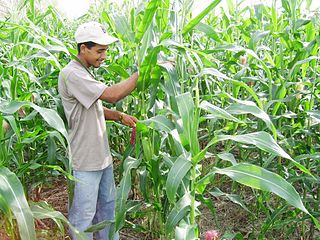
Agriculture in Panama is an important sector of the Panamanian economy. Major agricultural products include bananas, cocoa beans, coffee, coconuts, timber, beef, chicken, shrimp, corn, potatoes, rice, soybeans, and sugar cane.

The Ministry of Agriculture of Taiwan, formerly the Council of Agriculture, is the ministry under the Executive Yuan of the Republic of China (Taiwan) in charged with overseeing affairs related to agriculture, forestry, fishery, animal husbandry and food affairs. CAO is actively participating various FAO-led activities.

Tsao Chi-hung is a Taiwanese politician. A member of the Democratic Progressive Party, he was a member of the National Assembly from 1992 to 1994 and has served two terms each in the Legislative Yuan and as Pingtung County Magistrate. Between 2016 and 2017, Tsao was minister of agriculture.

Mining has been practiced in Taiwan for hundreds of years. Sulfur was an early important resource collected on the island. Coal mining expanded in the 19th century to keep up with demand from increased foreign trade. Heavy industry was further expanded under Japanese rule, but air raids towards the end of World War II decimated mining infrastructure, falling below 19th century production levels. Copper mining expanded in the mid-20th century, but ended in the 1980s following a global collapse in the price of copper.

Floriculture is a significant industry in Taiwan. Taiwan is one of the largest flower exporters in the world and the top producer of orchids.

Pineapple is one of the fruit crops produced in Taiwan.
Freedom pineapples was a political and social response in 2021 to a Chinese ban on the import of pineapples from Taiwan. The response encouraged domestic and international consumption to replace the loss of the mainland Chinese market, which had formerly imported 97% of all Taiwanese pineapple exports. The movement was particularly well-received by Taiwanese, Japanese, Australian and American audiences, but did not fully shield Taiwan from the economic consequences. In 2021, Taiwanese pineapple exports dropped to 55% of their 2019 levels.
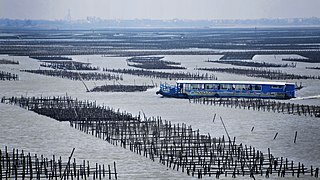
Aquaculture has a long history in Taiwan and is an important component of the Maritime industries of Taiwan.
{{cite web}}: CS1 maint: multiple names: authors list (link){{cite web}}: CS1 maint: archived copy as title (link)